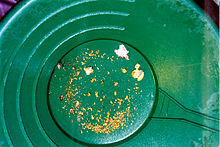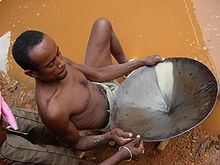Gold panning: Difference between revisions
m Reverted edits by 65.118.209.110 (talk) to last version by ClueBot NG |
|||
| Line 13: | Line 13: | ||
In many situations, gold panning usually turns up only minor gold dust that is usually collected as a souvenir in small clear tubes. Nuggets and considerable amounts of dust are occasionally found, but panning mining is not generally lucrative. Panning for gold can be used to locate the parent gold [[Vein (geology)|veins]] which are the source of most placer deposits. |
In many situations, gold panning usually turns up only minor gold dust that is usually collected as a souvenir in small clear tubes. Nuggets and considerable amounts of dust are occasionally found, but panning mining is not generally lucrative. Panning for gold can be used to locate the parent gold [[Vein (geology)|veins]] which are the source of most placer deposits. |
||
== |
==Pancer== |
||
[[File:Pans et batée de diverses origines.jpg|thumb|400px|Various designs of gold pans from around the world]] |
[[File:Pans et batée de diverses origines.jpg|thumb|400px|Various designs of gold pans from around the world]] |
||
Gold pans of various designs have been developed over the years,<ref name=Special2>{{cite web|accessdate=August 30, 2010|url=http://www.mine.mn/Gold_Pan.htm|title=GOLD PANS of every shape|author= Various|work=ECO-MINEX INTERNATIONAL LTD}}</ref> the common features being a means for trapping the heavy materials during agitation, or for easily removing them at the end of the process. Some are intended for use with [[mercury (element)|mercury]], include screens, sharp corners for breaking ice, are non-round, or are even designed for use "with or without water". |
Gold pans of various designs have been developed over the years,<ref name=Special2>{{cite web|accessdate=August 30, 2010|url=http://www.mine.mn/Gold_Pan.htm|title=GOLD PANS of every shape|author= Various|work=ECO-MINEX INTERNATIONAL LTD}}</ref> the common features being a means for trapping the heavy materials during agitation, or for easily removing them at the end of the process. Some are intended for use with [[mercury (element)|mercury]], include screens, sharp corners for breaking ice, are non-round, or are even designed for use "with or without water". |
||
Revision as of 20:31, 2 April 2014


Gold panning, or simply panning, is a form of placer mining and traditional mining that extracts gold from a placer deposit using a pan. The process is one of the simplest ways to extract gold, and is popular with geology enthusiasts especially because of its cheap cost and the relatively simple and easy process.
It is the oldest method of mining gold.[1] The first recorded instances of placer mining are from ancient Rome, where gold and other precious metals were extracted from streams and mountainsides using sluices and panning.[2] However, the productivity rate is comparably smaller compared to other methods such as the rocker box or a large extractor such as in 'The Pit', in Kargoorlie, which have led to it largely being replaced in areas with capital for more sophisticated equipment.
Process
Gold panning is a simple process. Once a suitable placer deposit is located, some gravel from it is scooped into a pan, where it is then gently agitated in water and the gold sinks to the bottom of the pan. Materials with a low specific gravity are allowed to spill out of the pan, whereas materials with a high specific gravity sink to the bottom of the sediment during agitation and remain within the pan for examination and collection by the gold panner. These dense materials usually consist primarily of a black, magnetite sand with whatever gemstones or metal dust that may be found in the deposit that is used for source material.
While an effective method with certain kinds of deposits, and essential for prospecting, even skilled panners can work but a limited amount of material, significantly less than the other methods which have replaced it in larger operation.[3] Pans remain in use in places where there is limited capital or infrastructure, as well as in recreational gold mining.
In many situations, gold panning usually turns up only minor gold dust that is usually collected as a souvenir in small clear tubes. Nuggets and considerable amounts of dust are occasionally found, but panning mining is not generally lucrative. Panning for gold can be used to locate the parent gold veins which are the source of most placer deposits.
Pancer

Gold pans of various designs have been developed over the years,[4] the common features being a means for trapping the heavy materials during agitation, or for easily removing them at the end of the process. Some are intended for use with mercury, include screens, sharp corners for breaking ice, are non-round, or are even designed for use "with or without water". Edward Otho Cresap Ord, II, a former Army officer and co-owner of several mines, patented several pan designs including designs for use with mercury or dry.[4]
Pans are measured by their diameter in inches or centimeters. Common sizes of gold pans today ranges between 10–17 inches (25–43 cm), with 14 inches (36 cm) being the most used size. The sides are generally angled between 30° to 45°.[3][5]
Pans are manufactured in both metal and high impact plastic. Russia iron[6][5] or heavy gauge steel pans are traditional. Steel pans are heavier and stronger than plastic pans. Some are made of lightweight alloys for structural stability. Plastic gold pans resist rust, acid and corrosion, and most are designed with moulded riffles along one side of the pan. Of the plastic gold pans, green and red ones are usually preferred among prospectors, as both the gold and the black sand stands out in the bottom of the pan.
Batea

The batea (Spanish for "gold pan")[7] is a particular variant of gold pan.[5] Traditionally made of a solid piece of wood,[5] it may also be made of metal. Bateas are used in areas where there is less water available for use than with traditional gold pans, such as Mexico and South America, where it was introduced by the Spanish.[5][6] Bateas are larger than other gold pans, being closer to 20 inches (51 cm) in diameter.[5]
References
- ^ History of Gold, 2007-10-18, retrieved 2009-12-14
- ^ Lynn Cohen Duncan (1999-12-09), Roman Deep-vein Mining, retrieved 2009-12-14
- ^ a b Silva, Michael A. (1986). Placer Gold Recovery Methods (No. 87). Sacramento, California: California Division of Mines and Geology. pp. 2–3.
- ^ a b Various. "GOLD PANS of every shape". ECO-MINEX INTERNATIONAL LTD. Retrieved August 30, 2010. Cite error: The named reference "Special2" was defined multiple times with different content (see the help page).
- ^ a b c d e f Placer Mining: A Hand-book for Klondike and Other Miners and Prospectors. Scranton, Pa.: Colliery Engineering Co. 1897. pp. 96–97.
- ^ a b Wilson, E. B. (1907). Hydraulic and Placer Mining. New York: John Wiley & Sons. pp. 30–33.
- ^ Raymond, R.W. (1881). Glossary of Mining and Metallurgical Terms. Easton, Pa.: American Institute of Mining Engineers.
